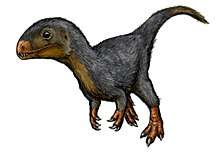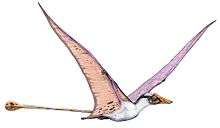Daemonosaurus
| Daemonosaurus | |
|---|---|
 | |
| Reconstructed skull, which interprets the "buck teeth" as being due to the teeth loosening from their sockets | |
| Scientific classification | |
| Kingdom: | Animalia |
| Phylum: | Chordata |
| Clade: | Dinosauria |
| Order: | Saurischia |
| Suborder: | Theropoda |
| Genus: | †Daemonosaurus Sues et al., 2011 |
| Species: | †D. chauliodus |
| Binomial name | |
| Daemonosaurus chauliodus Sues et al., 2011 | |
Daemonosaurus (pron.:"DAY-mow-no-SORE-us") is an extinct genus of theropod dinosaur from the Late Triassic of New Mexico. Fossils have been found from deposits in the Chinle Formation, which is latest Triassic in age. While theropods had diversified into several specialized groups by this time, Daemonosaurus is a basal theropod that lies outside the clade Neotheropoda. Daemonosaurus is unusual among early theropods in that it had a short skull and long protruding teeth.[1][2]
Description

Based on the proportions of related theropods, Daemonosaurus is estimated to have been around 1.5 m (5 feet) long.[2] Other estimates suggest that Daemonosaurus was at most 2.2 m (7 ft) long and weighed 22 kilograms (49 pounds).[3] The skull of Daemonosaurus differs considerably from all other Triassic theropods. The snout is short and bears large premaxillary and maxillary teeth in the upper jaw. Procumbent teeth project forward from the tips of the upper and lower jaws,[1] which is highlighted in the species name chauliodis that roughly means "buck-toothed".[4] Daemonosaurus is unique among Triassic theropods because it has an unusually short snout, and all other early theropods had long heads and jaws. Like the coelophysoids, Daemonosaurus has a kink in its upper jaws, between the maxilla and the premaxilla.
The proportionately large orbit, the short snout, and the apparent lack of fusion between the bones of the braincase suggest that the holotype specimen CM 76821 may be an example of a juvenile dinosaur. On the other hand, the closure (fusion) of the neurocentral sutures in the vertebrae suggest a mature individual.
Discovery
Daemonosaurus is known from the single holotype CM 76821, which consists of a skull, mandibles, an atlas bone, an axis bone, neck vertebrae, and rib fragments discovered at Ghost Ranch. Ghost Ranch is famous for an abundance of fossils of the similar theropod Coelophysis. Fossils of Coelophysis were present on the same block that contained the skull of Daemonosaurus, which was uncovered by a volunteer at the State Museum of Pennsylvania.[1][2] In 2011, Fred Bervoets noted that "it is possible that additional postcranial bones will be retrieved during further preparation of the large block C-4-81 in which CM 76821 was discovered in association with skeletal remains of C. bauri."
Daemonosaurus was named by Hans-Dieter Sues, Sterling J. Nesbitt, David S. Berman and Amy C. Henrici in the journal Proceedings of the Royal Society B in 2011 and the type species is Daemonosaurus chauliodus. The generic name Daemonosaurus is derived from the Greek words "daimon" (δαίμων) meaning "demon" and "sauros" (σαύρα) meaning "reptile". The specific name is derived from the Greek word "chauliodous" (χαυλιόδους) meaning "prominent toothed", which is in reference to its procumbent front teeth.[1]
Classification
Daemonosaurus is a basal theropod that lies outside the clade Neotheropoda,[5] a group that includes more advanced Triassic theropods like Coelophysis and their descendants. With such a basal position, it represents a lineage that extended from the earliest radiation of dinosaurs in the Middle Triassic with forms such as Eoraptor and Herrerasaurus from South America. A phylogenetic analysis conducted in its original description found Daemonosaurus chauliodus to be closely related to Tawa hallae, a theropod that was described from Ghost Ranch in 2009, and the Neotheropoda. Although the two theropods are closely related, Tawa was found in a quarry that is slightly older than Ghost Ranch. Sues et al. (2011) noted that the discovery of Daemonosaurus provided "additional support for the theropod affinities of both Eoraptor and Herrerasauridae and (demonstrated) that lineages from the initial radiation of Dinosauria persisted until the end of the Triassic."[5] Below is a cladogram based on the phylogenetic analysis conducted by Sues et al. in 2011, showing the relationships of Daemonosaurus:[1]
| Theropoda |
| ||||||||||||||||||||||||||||||||||||||||||||||||||||||||||||||||||||||||
Examination of this genus by Sues et al. (2011) demonstrates that Daemonosaurus is separate and distinct from its other contemporaries.[1] Daemonosaurus differs from Herrerasaurus based on key features in the skull and because it has much larger teeth in the premaxilla. Daemonosaurus differs from Eodromaeus based on features of the jaw bone, skull, cheek bones, and because it has much larger teeth in the premaxilla. Daemonosaurus differs from Eoraptor lunensis based on the presence of much larger premaxillary and anterior maxillary teeth and a much more restricted antorbital fossa on the maxilla. Daemonosaurus differs from Tawa hallae and Coelophysis bauri in features of the skull bones. Daemonosaurus differs from Chindesaurus bryansmalli in features of the cervical vertebrae.
Distinguishing anatomical features
A diagnosis is a statement of the anatomical features of an organism (or group) that collectively distinguish it from all other organisms. Some, but not all, of the features in a diagnosis are also autapomorphies. An autapomorphy is a distinctive anatomical feature that is unique to a given organism or group.
According to Sues et al. (2011), Daemonosaurus can be distinguished based on the following features:[5]
- the skull is proportionately deep and narrow, with a short antorbital region
- the antorbital fenestra is nearly the same size as the external naris (possible autapomorphy)
- the long posterior process of the premaxilla almost contacts the anterior process of the lacrimal bone (possible autapomorphy)
- the ventral process of the lacrimal bone has a slender posterior projection extending along anterodorsal margin of the jugal bone
- the jugal is dorsoventrally deep and has a prominent lateral ridge; and the alveolar margin of the dentary is downturned at the symphysis
- the postorbital with anterolateral overhang over the orbit; and the prefrontal is large and occupies about 50% of the dorsal margin of the orbit
- the first two dentary teeth are large and procumbent; and the premaxillary and anterior maxillary teeth are much enlarged relative to the posterior maxillary teeth
- the third cervical vertebra has a deep, rimmed, ovoid pleurocoels on the anterolateral surfaces of both the centrum and the neural arch
Paleoecology
Provenance and occurrence
The only specimen of Daemonosaurus was recovered at the Ghost Ranch (Whitaker) quarry at the Siltstone Member of the Chinle Formation in Rio Arriba County, New Mexico. Its remains were collected in the 1980s by E.H. Colbert in pebbly, calcareous conglomerate from the Rhaetian stage of the Triassic period, approximately 208 to 201 million years ago. This specimen is housed in the collection of the Carnegie Museum of Natural History, in Pittsburgh, Pennsylvania.
Fauna and habitat
Ghost Ranch was located close to the equator 200 million years ago, and had a warm, monsoon-like climate with heavy seasonal precipitation. Whitaker Quarry, at Ghost Ranch, New Mexico, was the paleoenvironment for a diverse collection of rhynchocephalians, like Whitakersaurus, archosauromorphs and archosaurs, parasuchid reptiles like Redondasaurus, crocodilians like Hesperosuchus, pseudosuchians like Effigia, the dinosauromorph Eucoelophysis, and the dinosaur Coelophysis.[6]
Taphonomy
The multitude of specimens deposited so closely together at Ghost Ranch was probably the result of a flash flood event. Such flooding was commonplace during this period of the Earth's history and, indeed, the nearby Petrified Forest of Arizona is the result of a preserved log jam of tree trunks that were caught in one such flood. In 1989, Colbert noted that the Daemonosaurus specimen and several Coelophysis specimens were washed into a small pond, where they drowned and were buried by a sheet flood event from a nearby river."[6]
References
- 1 2 3 4 5 6 Hans-Dieter Sues; Sterling J. Nesbitt; David S. Berman & Amy C. Henrici (2011). "A late-surviving basal theropod dinosaur from the latest Triassic of North America". Proceedings of the Royal Society B. 278 (1723): 3459–3464. doi:10.1098/rspb.2011.0410. PMC 3177637. PMID 21490016.
- 1 2 3 Choi, C.Q. (12 April 2011). "T. Rex had a toothy ancestor that couldn't cut it". Live Science. Retrieved 12 April 2011.
- ↑ "Daemonosaurus". DinoChecker.com. Retrieved 5 May 2013.
- ↑ "Missing link ties older to newer dinosaurs". CBS News. Retrieved 2011-04-14.
- 1 2 3 H.D. Sues, S. J. Nesbitt, D. S. Berman and A. C. Henrici. 2011. A late-surviving basal theropod dinosaur from the latest Triassic of North America. Proceedings of the Royal Society B 278:3459-3464
- 1 2 E. H. Colbert. 1989. The Triassic dinosaur Coelophysis. Museum of Northern Arizona Bulletin 57:1-174



